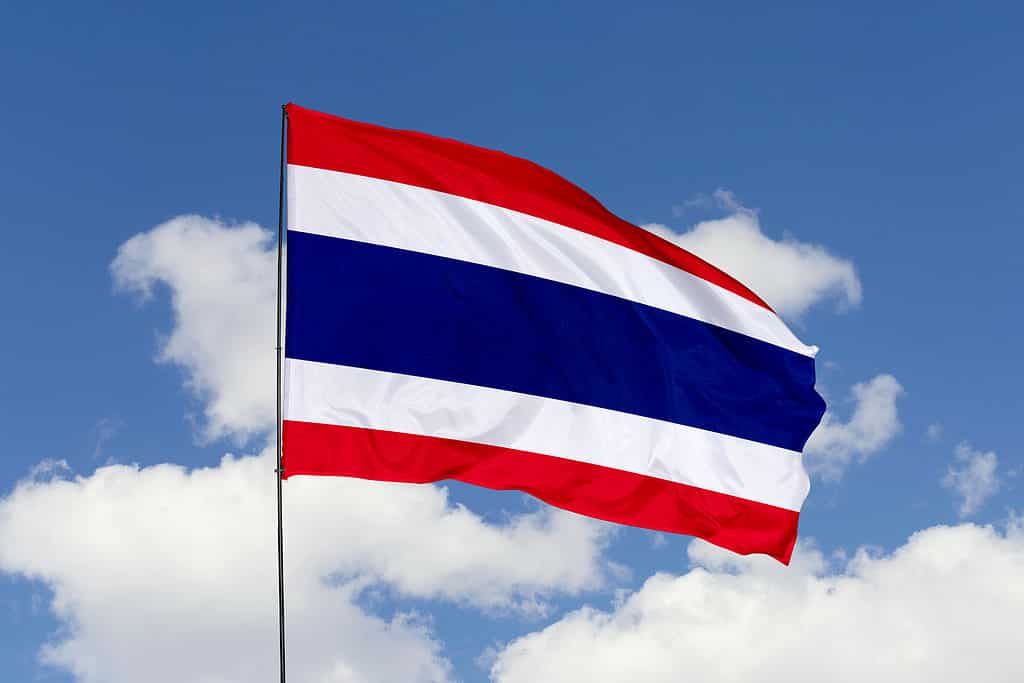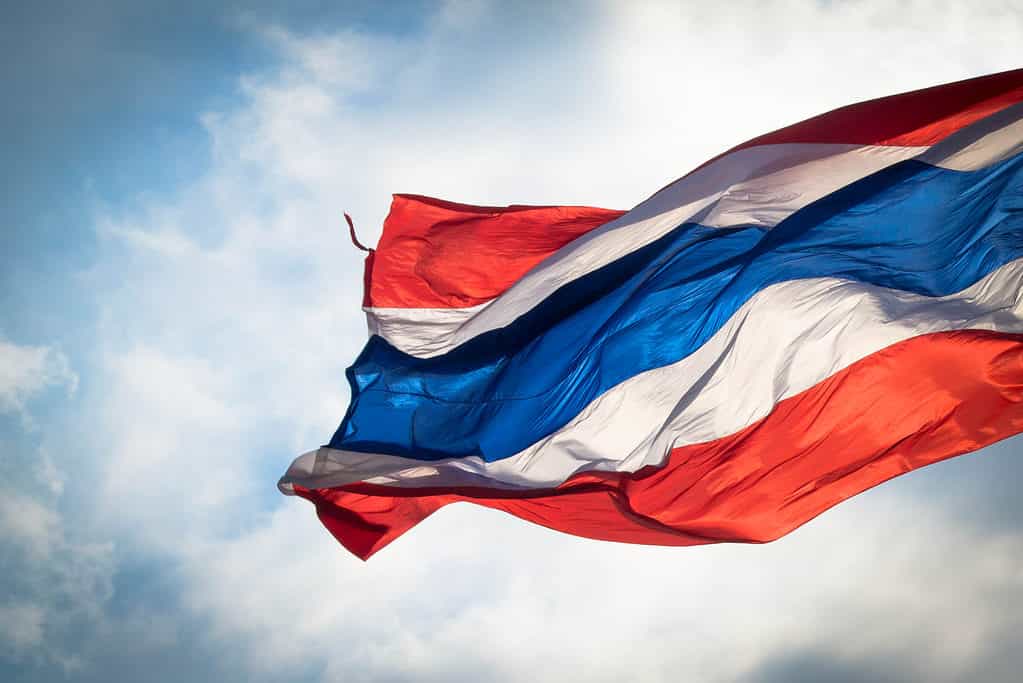Flags are most commonly utilized as national symbols since they combine a nation’s past, present, and future goals into one. Thailand, formerly known as Siam, but now officially recognized as the Kingdom of Thailand, is a nation in Southeast Asia. It is situated inside this Indochinese Peninsula’s geographic center. It has an area of 198,120 square miles and a population of nearly 70 million. The flag of Thailand is among the oldest in use today. Rama VI’s royal proclamation of September 28, 1917, is credited with its official adoption. Locally, the term for the country’s flag is Thong Trairong, which translates to “tricolor.” In this article, we’ll go deeper into the flag of Thailand, including its history, symbolism, and meaning.
Flag of Thailand History

The flag of Thailand features the colors red, white, and blue, also known as the “colors of liberty.”
©Tatohra/Shutterstock.com
When it first came into use, possibly in the 17th century, the Thai national flag was simply red. It became vital to add a symbol to the design for easy recognition as other states began flying comparable flags. In 1782, a white chakra or wheel, the symbol of the ruling Chakri dynasty, was first added to the navy’s flag. In 1855, a crimson flag with a white elephant in the middle was flown by both the navy and privately operated ships. The uncommon white elephant has a long history of being associated with the land as a lucky sign.
Thailand was among the few Asian countries that avoided European imperialism, but because of its close relations with the West, it was included in the Allies during World War I. In recognition of the relationship, King Rama VI altered the national flag into a more “modern” design. On November 21, 1916, the elephant was replaced by two horizontal white stripes placed against a red background. The center red stripe was changed to a blue one on September 28, 1917. The “colors of liberty” (red, white, and blue) are now on the flag of Thailand. These colors are also flown by allies Britain, France, Russia, and the United States. The navy adopted the same flag but inserted a white elephant on a central red disk.
Flag of Thailand Meaning

The flag of Thailand is represented by the colored horizontal stripes red, white, blue, white, then red. It contains no symbol.
©Saranya Loisamutr/Shutterstock.com
Five horizontal stripes (red/ white/ blue/ white/ red) make up the Thai flag. The center blue stripe is twice as broad as the other stripes. Rama VI, according to legend, ordered the creation of a new, symmetrical flag after noticing the flag dangling upside-down after a flood. Dark blue was used as the central color later in 1917. The flat stripes that make up the Thai flag’s design carry a lot of symbolism. The meaning of the flag is conveyed by its colors, which are said to represent the nation-religion-king, which is the nation’s unofficial emblem. Let’s investigate its colors in more detail.
Colors and Design:
On September 30, 2017, a statement from the Office of the Prime Minister standardized the colors of the flag. This was to mark the commemoration of the establishment of the flag 100 years prior. Thailand’s national flag is displayed in the following colors: red, white, blue, white, and red. On a red background, two horizontal white stripes encircle a central blue stripe. The structure of royalty that rules the nation is symbolized by the color blue.
The blue stripe in the middle is twice as wide as the other four stripes combined. In terms of tone, this blue is similar to indigo. According to some interpretations, the color blue was chosen as a symbol of solidarity with the World War I Allies, since their flags also used blue, red, and white. Red is considered to signify the bloodshed of the Thai people for their country, and white is thought to represent religious laws and the purity of Buddhism. Thailand refers to these as its “colors of liberty.”
Flag of Thailand Symbolism

The colors of the flag of Thailand are said to symbolize sacrifice (red), purity (white), and monarchy (blue).
©jakapan Chumchuen/Shutterstock.com
Briefly said, Thailand’s flag represents nation-religion-king, a sort of unspoken creed that Thai people follow. The crimson stripes stand for the bloodshed or sacrifice by Thailand in its fight for independence. The white stripes signify purity and Buddhism, the nation’s official religion. The blue stripes stand for the Thai monarchy.
Up Next:
- The Flag of Djibouti: History, Meaning, and Symbolism
- The Flag of Egypt: History, Meaning, and Symbolism
- The Flag of Equatorial Guinea: History, Meaning, and Symbolism
The photo featured at the top of this post is © IznoDesign/Shutterstock.com
Sources
- Flags of the World, Available here: https://www.fotw.info/flags/th.html
- Gettysburg Flag, Available here: https://www.gettysburgflag.com/flags-banners/thailand-flags
- The Culture Trip, Available here: https://theculturetrip.com/asia/thailand/articles/the-story-behind-the-colours-of-thailands-flag/
Thank you for reading! Have some feedback for us? Contact the AZ Animals editorial team.






